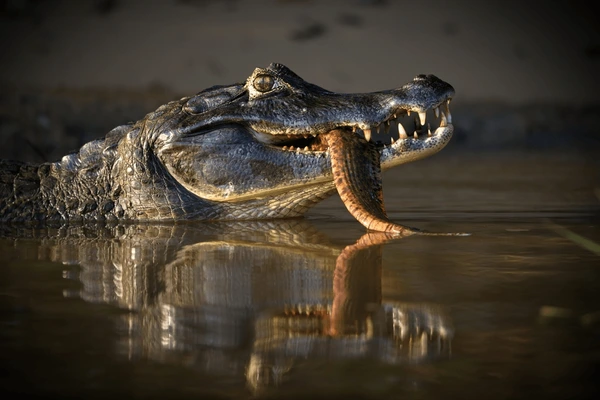
Crocodilia Cohorts - Story of Black Caiman
Endemic to the Amazon River Basin, the Black Caiman is an apex predator and the largest species of the Alligatoridae, reaching a maximum length of 20 feet and weighing over one thousand pounds. Black Caiman is one of six different species of Caiman, and it is also the largest. As opportunistic predators, the primary food sources are capybaras, monkeys, pythons, fish, armadillos, river otters, and occasional cannibalism.
Reaching sexual maturity around eight years of age, the Black Caiman deposits up to 60 softshell eggs into a nest built by the mother near the river's edge. As dedicated parents, the mother caiman spends weeks safely monitoring the nest to protect from predators, the most common egg predators being snakes, rats, and birds. When hatched, the baby Black Caiman measures about ten inches long and possesses similar camouflage coloring and physical attributes as adult Black Caiman. Active involvement from the mother continues up to two years after hatching to avoid predation of the young, which significantly increases due to their small size and increased exposure to threats traversing both land and water.
Primarily active at night, Black Caimans are highly efficient predators with an acute auditory system permitting the ability to process sound frequencies beyond human capabilities. With heightened audible detection paired with their large size and ambush-style hunting tactics, Black Caimans have reportedly attacked and killed prey as large as cattle, jaguars, and anacondas.
Like other species of Alligatoridae and Crocodilia, Black Caiman cannot chew their food; thus, with more extensive food items, Black Caimans are either reliant on other caimans to assist in disassembling their prey to begin consumption or are required to stow their food item, permitting the passage of time and the elements to soften muscle and tissue during the decay process to aid in disassembly.
A social hierarchy is developed among the Black Caiman community in which the largest and most dominant is provided the Alpha distinction. With this Alpha designation, he is first to eat any food item scavenged, and this hierarchy aids the overall community by avoiding unnecessary conflicts. Emitting a low rumbling sound is dually used to communicate during mating season and is applied for social hierarchy purposes.
Lesson: Despite being an Apex predator, the largest of the species is still reliant on the assistance of others to accomplish specific tasks, namely reproduction and consumption of large food items through group participation. In modern terms, even companies with the largest market share and the “Alpha” organization distinction still require strategic partnerships to accomplish specific tasks and goals.
TLDR: A history of success as a dominant organization does not offer protection from the next round of emerging threats. Being ever-vigilant and aware of changes in the market, new competition, and innovation threatening one's position is critical to survival.